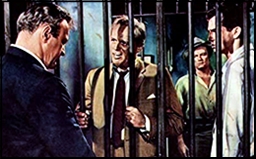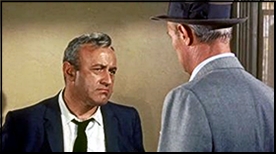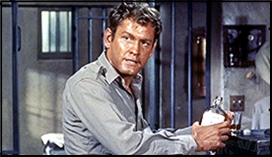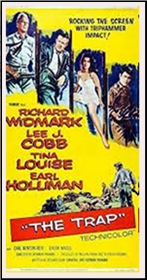Sat 25 Apr 2020
A Movie Review by Jonathan Lewis: THE TRAP (1959).
Posted by Steve under Action Adventure movies , Reviews[4] Comments

THE TRAP. Paramount Pictures, 1959. Richard Widmark, Lee J. Cobb, Tina Louise, Earl Holliman , Carl Benton Reid, Lorne Greene, Peter Baldwin. Director: Norman Panama.
After about ten minutes, I was about to give up on The Trap. That would have been a big mistake. What first appears to be a middling family drama slowly gives way to a gritty and violent desert noir. There is something just so stagy about the opening sequences that makes me wonder whether other people have dismissed this rather obscure crime film out of hand. Because it certainly doesn’t seem to have wide appeal, let alone be referred to very often by noir or crime film enthusiasts.
While it’s by no means a masterpiece and has more than its fair share of limitations, The Trap is an overall taut and enjoyable little thriller. Richard Widmark, always enjoyable in my book, portrays Ralph Anderson, a shyster lawyer tasked by the mob to arrange for an airstrip in his small California hometown to be operational.

Why is this such a big deal, you might ask yourself. Well, it’s because fugitive mob boss Victor Massonetti (Lee J. Cobb) needs an airfield to flee the country. So, Ralph shows up in his small desert hometown for the the first time in ten years and pleads with his father, the town sheriff, to keep the airfield open. His brother Tippy (Earl Holliman), who is now married to his high school sweetheart Linda (Tina Louise), would rather just collect the reward. There’s a longstanding feud between the two brothers which plays out over the course of the film. It’s an important part of the plot, but nothing you haven’t seen repeated time and again in westerns.

Overall, The Trap is successful in its storytelling. The movie moves at a fairly rapid clip and whenever it does seem to be slowing down or going in circles, it picks itself up and charges in a new and often surprising direction. Widmark and Cobb give solid performances, even if the latter’s rendition of what a mob boss should sound like gets repetitive and downright grating.
What’s distinctly lacking in the movie is any real cinematic sense. Although the movie is set against harsh desert vistas, neither the director nor cinematographer seemed interested or willing to fully capture the landscape in any meaningful sense. Rather, we often get a made for television aesthetic. Not bad, by any means. But just not something visually intoxicating. One wonders whether the movie would have actually been better had it been filmed in black and white.
Nevertheless, The Trap is worth a watch. It may not be among Widmark’s best films from the era, but if you like him as an actor, you will surely mind much to appreciate in this one. One final note. Lorne Greene, who I always enjoy, has a supporting role as a mob enforcer.

April 25th, 2020 at 9:20 pm
The film has a minor reputation among noir enthusiasts, but as said misses quite a few opportunities before kicking in as a “gritty violent” exercise as Jonathan says. There is a relative handful of desert noir films, and this one is quite good. Not great, but very good.
April 25th, 2020 at 10:10 pm
Strangely for me, not only is this a Richard Widmark movie I have never seen, until Jon told me he was watching it, I’d never even heard of it.
April 26th, 2020 at 12:39 pm
I had the experience of flipping the dial one night and having this come up sometime after the title credits. No idea what it was, when it started or how lonng it had to go. Like Jonathan I was pleasantly surprised at how it turned out!
May 1st, 2020 at 10:16 am
Carl Benton Reid: One of Hollywood’s stalwart authority figures, sometimes muddle-headed, delusional, or downright corrupt. Great actor.